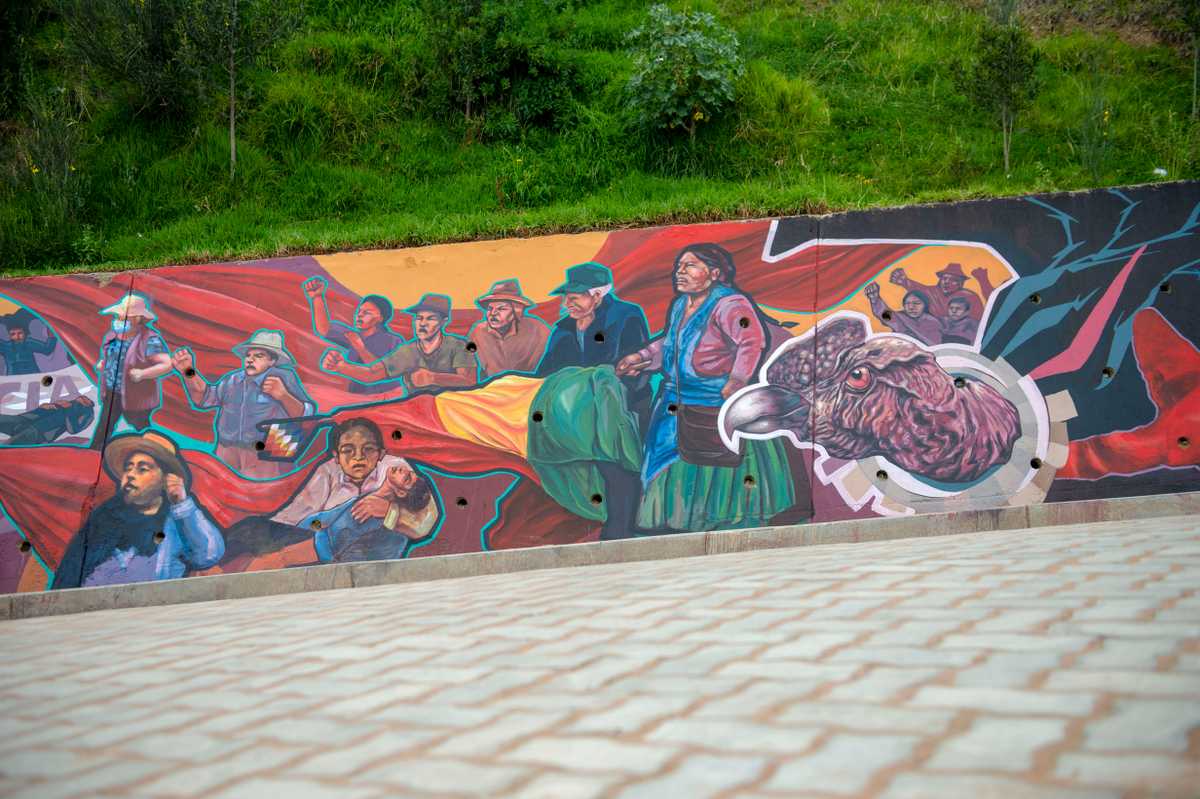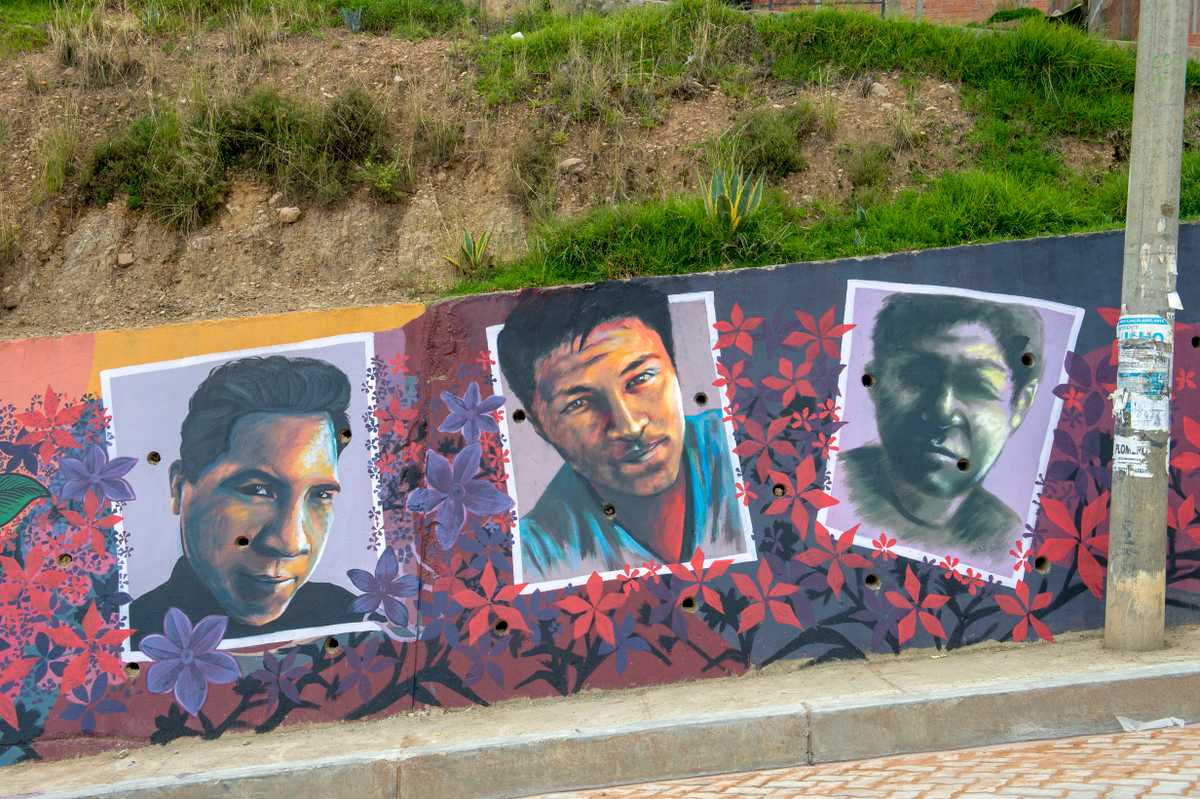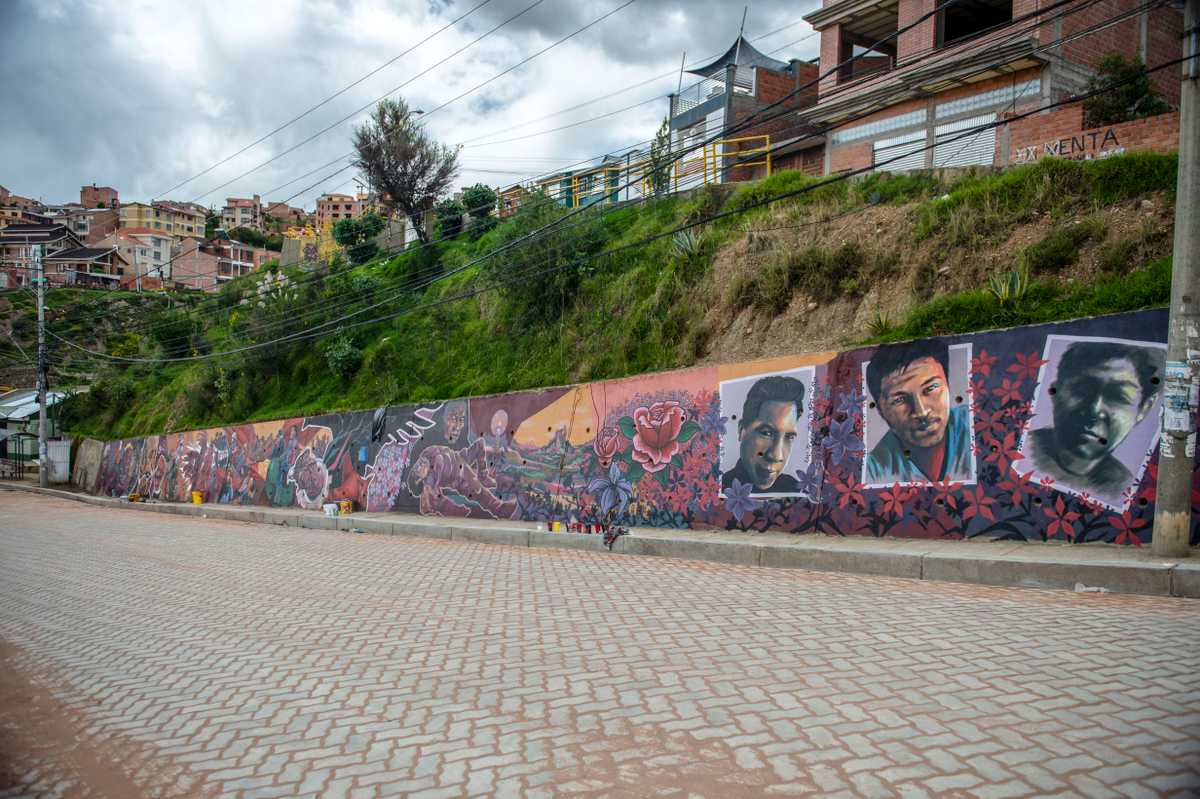We see the influence of artist Leonel Jurado clearly in this Bolivian mural, created to commemorate the victims of the massacres that followed the 2019 coup d’état.

In 2019, in the Plurinational State of Bolivia, the Organization of American States (OAS), and its Department for Electoral Cooperation and Observation, led by Gerardo de Icaza Hernández, reported electoral fraud that, as has been repeatedly demonstrated by multiple studies, never occurred. On November 11 2019, a military coup put power in the hands of newly installed de facto president, Jeanine Añez.
As Añez’s illegitimate rule was established, she deployed the armed forces and the police which, ignoring the Constitution and the results of the October 20 election, threatened to assassinate then-president Evo Morales and his vice-president Álvaro García Linera. Añez’s rule incited violence against MAS (Movement Toward Socialism) sympathizers, an overwhelmingly Indigenous population who protested en masse this armed assault on their democracy. It cost them the loss of hundreds of lives. The Armed Forces that executed these massacres acted with total impunity, due to a decree, issued by Añez, that protected them from prosecution.

A PI election observer mission was in Bolivia for the October 2020 elections, and was able to observe in-person the mobilization of the Bolivian people. The MAS candidate Luis Arce won this election handily, but this election only ever took place in the first place thanks to the resistance of the people, who very clearly grasped the illegitimacy of Añez’s dictatorial regime and fought to regain their popular sovereignty.
Leonel, an artist from La Paz, tells us about his new mural, which commemorates the victims of the post-coup massacres. He explains that he has himself been a victim of threats, ‘‘The armed forces are still active, the coup plotters are still here’’. In reaction to the mural, Leonel and his peers were harrassed. ‘‘They insulted us, they threatened us with erasing it, from the mayoralty of the area, to the police… and they will continue to attack this project’’.
‘‘We are Indigenous people, we always protest. We are regarded as heroes, always fighting’’, he says, asking, ‘‘Why does it have to be like this? Why does it need to be us in the streets, facing the police and their ammunition? Why does it always have to be the Indigenous people? It is regrettable that this needs to happen at all’.

Leonel explains that the mural has been made with the collaboration of Wiphalas Across the World and the association of the victims of southern La Paz. ‘‘This mural aims to tell our story, to tell the truth of what happened’’, he says, ‘‘For that purpose, I have listened to the stories of the victims and the persecuted families. This has been a collaborative creation’’. In the mural, we find the photographs of the victims, personal stories, like the one of ‘‘Sister Frida”. “After her brother was assassinated, an old lady collected his body, which the police were trying to make disappear, and held a wake for him”. Animals, like the condor, which represents a spirit that ‘‘is perennially there taking care of the people’’, Sister Juana confronting the regime with the Wiphala flag, social movements holding their struggles. The mural portrays things that, in the process of its creation, many people had the chance to tell for the first time. ‘‘We want to continue painting because there is a lot of truth that has still not been told’’, Leonel says.
Claudia, a member of Wiphalas, highlights the importance of making it clear to the world that there is no doubt that what happened in 2019 was a coup. “There is a campaign to discredit the victims of the post-coup massacre, which makes it even more important for everyone to know there was a coup’’. She explains that justice, to them, means that coup plotters have due process. ‘‘This is not punishment nor persecution, we are talking about genocidal attacks and avoiding their reoccurrence — if these people do not receive due process, the damage they have inflicted and their crimes are normalized, and if they are normalized then they are institutionalized’’.
‘‘There is no freedom, no peace, no democracy, no rule of law in this country while our Indigenous siblings are being attacked; there can be none of that when fascist forces burn them, spit on them, beat them up’’, says Claudia. She is concerned about how ‘‘Indigenous people are criticized as being ignorant, which negates their visibility.” Anti-Indigenous racism, Claudia and Leonel agree, does not only come from the right-wing and the forces behind the coup, but rather permeates their society.
‘‘The Process of Change (Proceso de Cambio) that was brought by MAS aims to eliminate all Bolivian colonial structures and, before the coup, it redistributed goods in a significant manner, bringing justice to us Indigenous and Afro-Bolivian people. "It is about us not having to ask for the permission to exist’’, says Claudia. ‘‘Now we resist with the message that we never want to be treated as inferior again’’. They refuse to return to times before the Process of Change, and it was from this feeling that they gathered the strength to resist Añez’s regime. Support of the Process of Change is what most brings the Bolivian people together.

Luis Arce’s victory in October of 2020 did not take Wiphalas by surprise, and confirms, as Claudia emphasizes, that what happened the previous year was an illegitimate coup. ‘‘These people died at the hands of a minority, an elite incapable of accepting that we, as Indigenous people of this land, can govern our own country’’, she highlights.
Talking about the mural, Claudia tells us that many of them saw its images in real life. They reflect, ‘‘with profound realism the relationship between the people and the coup forces’’. Furthermore, ‘‘the mural is so important because it represents the oppression against progressive countries’’. She concludes, with hope, ‘‘Bolivia is capitalism’s worst nightmare’’.
Tiare Gatti Mora is a King’s College London and Central Saint Martins graduate, whose academic research focused on comparative literature, film, and political communication. She is an independent journalist, a collaborator of CTXT (Revista Contexto), and a political activist with the Progressive International.
Photos: Whipalas Across the World